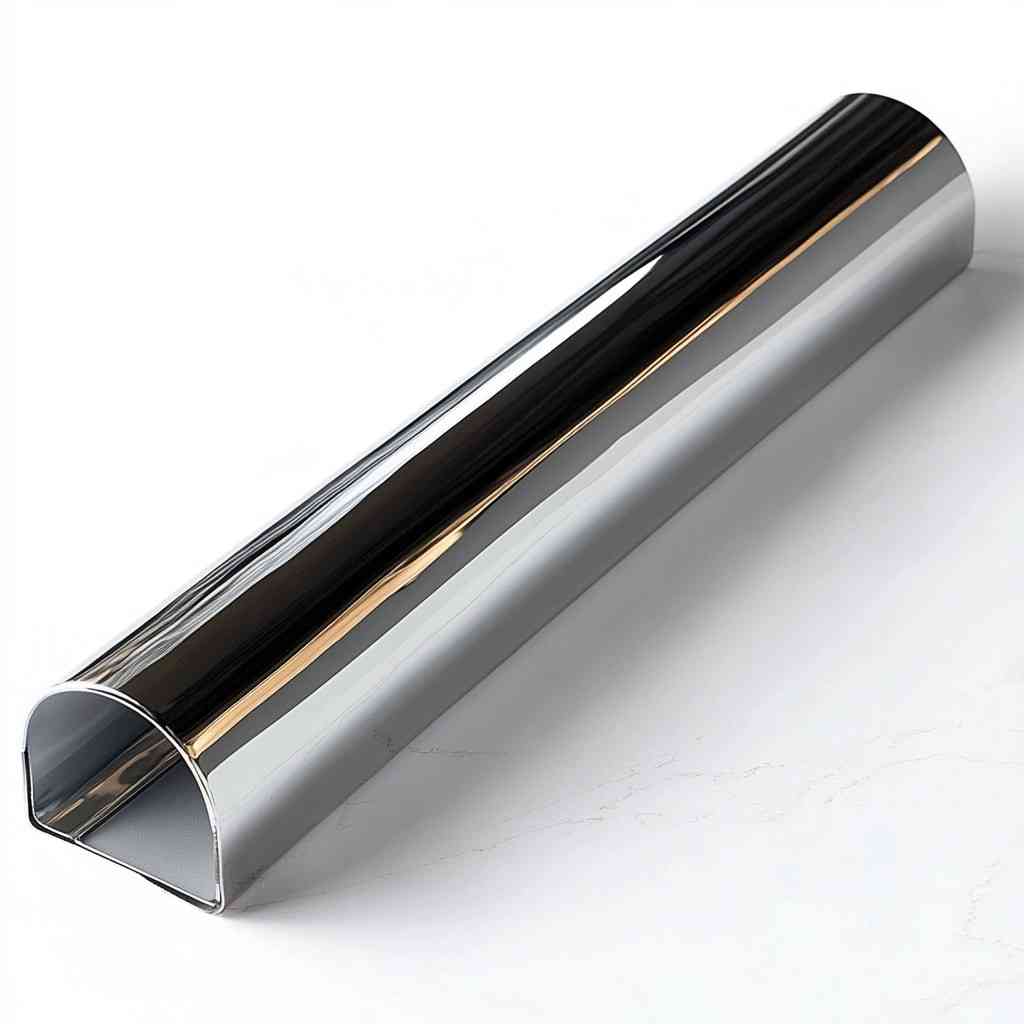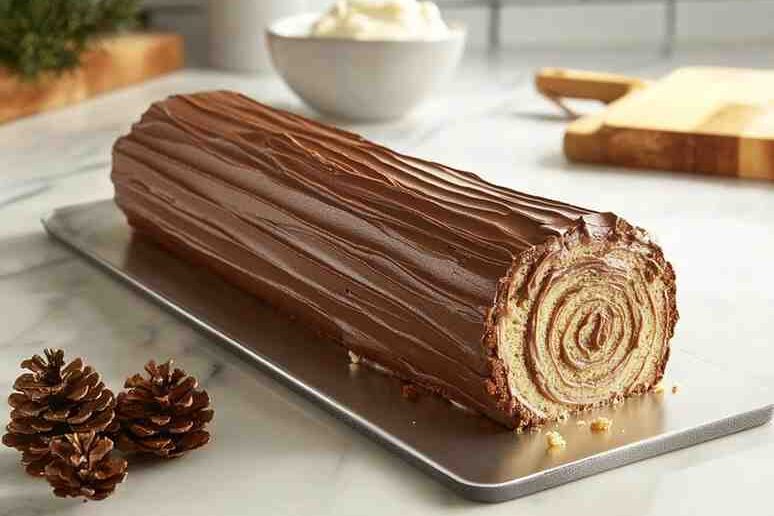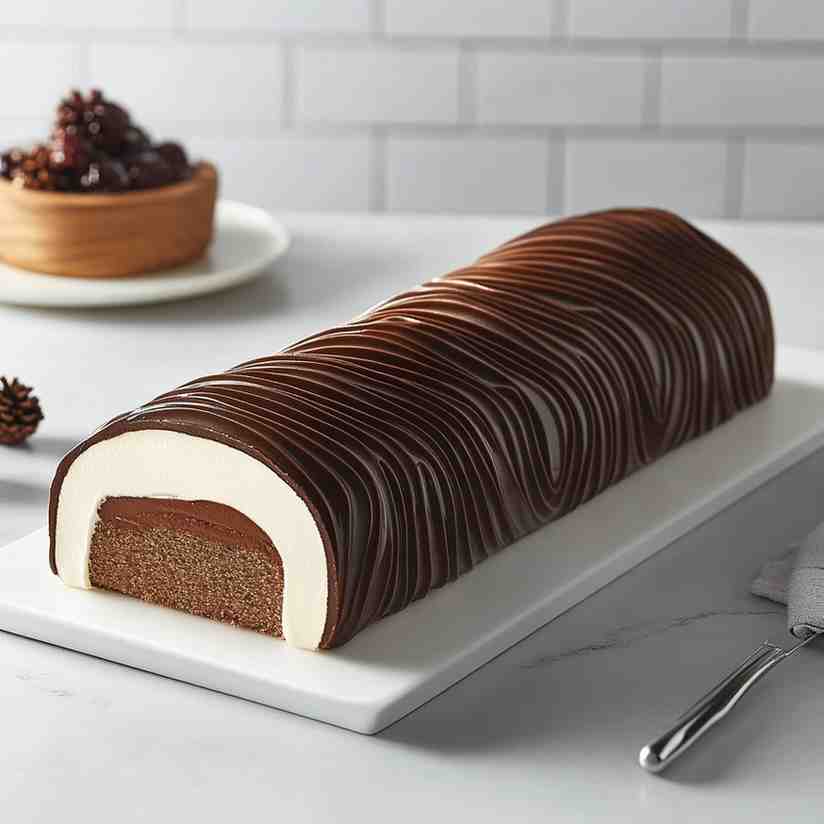The Caramel Yule Log, or Bûche de Noël au Caramel, is a modern twist on the classic French Christmas dessert. Combining rich caramel flavors with layers of textures, this dessert is crafted using a specialized mold, resulting in a polished, professional appearance.
A Brief History of the Yule Log Tradition
The Yule Log has deep roots in European holiday traditions. Historically, families would burn a wooden log in the fireplace during Christmas as a symbol of good fortune and warmth for the coming year. Over time, the burning log evolved into a dessert created by French pâtissiers. The cake mimics a real wooden log, complete with bark-like frosting and festive decorations.
What Makes the Caramel Yule Log Unique?
The Caramel Yule Log stands out for its bold flavor profile and intricate construction. Unlike traditional rolled Yule Logs, this version uses a mold, allowing for greater creativity and complexity.
Key Components of a Caramel Yule Log
- Caramel Mousse: Smooth and luxurious, with a deep caramel flavor.
- Vanilla Insert: A creamy contrast to the caramel.
- Pecan Nut Dacquoise: A nutty base layer that adds crunch.
- Caramel Glaze: A glossy finish that enhances the dessert’s visual appeal.
These components come together to create a harmonious blend of flavors and textures.
Mold Used in Yule Logs: A Game-Changer
Why Use a Mold?

The mold plays a crucial role in modern Yule Logs, offering advantages over the traditional rolled method:
- Consistent Shape: The mold ensures a uniform, sleek design.
- Layering Possibilities: It allows for multiple layers, including mousse, inserts, and crunchy elements.
- Ease of Decoration: Molded logs provide a smooth surface, making them ideal for glazes and intricate finishes.
Types of Molds
- Silicone Molds: Flexible and easy to use, they simplify the process of unmolding without damaging the dessert.
- Hard Plastic Molds: These are more rigid and often used for larger, professional-grade Yule Logs.
Tips for Using a Yule Log Mold
- Line with Acetate Sheets: This makes unmolding easier and ensures clean edges.
- Chill Thoroughly: Allow enough time for the layers to set before removing the mold.
- Avoid Overfilling: Leave some space at the top to prevent spillage when adding layers.
The Difference Between Rolled and Molded Yule Logs
Yule Logs come in two main styles: traditional rolled logs and modern molded versions. Each has its charm, but the techniques and outcomes differ significantly.
Rolled Yule Logs
- Construction: A flat sponge cake is spread with filling, then rolled into a cylinder.
- Texture: Offers a rustic, homemade feel.
- Challenges: Rolling the cake can lead to cracks if not done carefully.
Molded Yule Logs
- Construction: Layers are built in a mold, starting with mousse or inserts.
- Texture: Incorporates multiple textures, such as creamy mousse and crunchy bases.
- Challenges: Requires more precision and specialized equipment.
Varieties of Yule Logs Around the World
While the French Bûche de Noël is the most famous, other cultures have their own versions of this holiday dessert.
Italy: Tronchetto di Natale
The Italian Yule Log is similar to the French version but often includes mascarpone or ricotta in the filling for a lighter texture.
Switzerland: Swiss Roll Variants
Swiss Yule Logs often feature chocolate sponge cakes with cream-based fillings, emphasizing simplicity and elegance.
United States: Chocolate Roll Cake
In the U.S., Yule Logs are typically chocolate-based, filled with whipped cream or buttercream, and decorated with candy or fondant.
Why the Caramel Yule Log Is Worth the Effort
The Caramel Yule Log combines the elegance of French patisserie with bold flavors that impress at any holiday gathering. While it requires more steps than simpler desserts, the result is a show-stopping treat that’s as enjoyable to make as it is to eat.

The Recipe: Caramel Yule Log with Pecan Nut Dacquoise
This Caramel Yule Log recipe is built layer by layer, combining textures and flavors to create a festive centerpiece. The recipe includes a pecan nut dacquoise base, a creamy vanilla insert, a luscious caramel mousse, and a glossy caramel glaze.
Key Components
- Vanilla Insert
- Pecan Nut Dacquoise
- Caramel Mousse
- Caramel Glaze
Ingredients for Each Component
Vanilla Insert
- 250ml (1 cup) whole milk
- 2 egg yolks
- 50g (¼ cup) granulated sugar
- 20g (2 tablespoons) cornstarch
- 1 teaspoon vanilla extract
Pecan Nut Dacquoise
- 75g (¾ cup) powdered sugar
- 75g (¾ cup) ground pecans
- 3 large egg whites
- 50g (¼ cup) granulated sugar
Caramel Mousse
- 150g (¾ cup) granulated sugar
- 30ml (2 tablespoons) water
- 250ml (1 cup) heavy cream
- 4 egg yolks
- 4g (1 teaspoon) gelatin powder, bloomed in 2 tablespoons cold water
Caramel Glaze
- 150g (¾ cup) granulated sugar
- 75ml (⅓ cup) water
- 100ml (½ cup) heavy cream
- 5g (1 teaspoon) gelatin powder, bloomed in 2 tablespoons cold water
Step-by-Step Instructions
1. Prepare the Vanilla Insert
- Heat Milk: Warm the milk in a saucepan until it starts to simmer.
- Whisk Egg Mixture: In a separate bowl, whisk the egg yolks, sugar, and cornstarch until smooth.
- Temper the Eggs: Slowly pour the warm milk into the egg mixture while whisking continuously.
- Cook and Thicken: Return the mixture to the saucepan and cook over medium heat, stirring constantly, until it thickens.
- Freeze: Pour the custard into a small mold or container and freeze until solid.
2. Make the Pecan Nut Dacquoise
- Combine Dry Ingredients: Mix powdered sugar and ground pecans in a bowl.
- Whip Egg Whites: Beat the egg whites until soft peaks form. Gradually add the granulated sugar, beating until stiff peaks form.
- Fold Together: Gently fold the dry mixture into the egg whites.
- Bake: Spread the batter onto a parchment-lined baking sheet and bake at 180°C (350°F) for 15–18 minutes. Let cool and trim to fit the mold’s base.
3. Create the Caramel Mousse
- Make Caramel: Heat sugar and water in a saucepan until the sugar turns a deep amber color.
- Add Cream: Carefully pour the cream into the caramel while whisking. Let it cool slightly.
- Prepare Egg Mixture: Whisk the egg yolks in a bowl. Gradually pour the caramel into the yolks while whisking.
- Thicken: Return the mixture to the saucepan and cook over low heat until it thickens. Stir in the bloomed gelatin.
- Cool and Fold: Allow the caramel mixture to cool to room temperature. Whip the remaining cream to soft peaks and fold it gently into the caramel.
4. Assemble the Yule Log
- Line the Mold: Use acetate sheets to line your Yule Log mold for easy removal.
- Layer Components:
- Start with a layer of caramel mousse.
- Place the frozen vanilla insert in the center.
- Add more caramel mousse to cover the insert.
- Finish with the pecan nut dacquoise as the base.
- Chill: Freeze the assembled mold for at least 6 hours or overnight.
5. Finish with the Caramel Glaze
- Prepare the Glaze: Heat sugar and water in a saucepan until caramelized. Add cream and stir until smooth. Remove from heat and mix in bloomed gelatin.
- Cool: Let the glaze cool to a pourable consistency.
- Unmold and Glaze: Remove the log from the mold and place it on a wire rack over a baking sheet. Pour the caramel glaze evenly over the log.
Advanced Decorating Tips
The finishing touches transform your Yule Log from a delicious dessert to a show-stopping centerpiece.
Texture and Garnishes
- Add Textures: Use a fork to create bark-like lines on the glaze.
- Garnish with Nuts: Sprinkle chopped pecans on the sides for extra crunch.
Edible Decorations
- Meringue Mushrooms: Pipe meringue caps and stems, bake at low heat, and assemble with melted chocolate.
- Fresh Garnishes: Add sprigs of rosemary and cranberries for a festive touch.
Serving the Caramel Yule Log
Presentation Ideas
- Use a sleek platter to highlight the log’s glossy finish.
- Surround the log with edible decorations like meringue mushrooms or chocolate curls.
Pairing Suggestions
- Beverages: Pair the log with coffee, spiced tea, or a sweet dessert wine.
- Extras: Serve with a dollop of whipped cream or a scoop of vanilla ice cream for added indulgence.
Storing and Reheating
Refrigeration
- Store in an airtight container in the fridge for up to 3 days. Allow the log to sit at room temperature for 20 minutes before serving.
Freezing
- Freeze the assembled log (without glaze) for up to 2 months. Add the glaze after thawing.
Common Mistakes and How to Avoid Them
- Runny Mousse: Ensure the gelatin is fully dissolved and cool the mousse before folding in whipped cream.
- Cracked Glaze: Avoid pouring glaze that’s too hot or too cold; aim for a warm, pourable consistency.
- Dry Dacquoise: Watch the baking time carefully and remove the dacquoise from the oven as soon as it’s golden.
Why the Caramel Yule Log Is Worth the Effort
This dessert is more than just a treat—it’s an experience. The combination of flavors and textures, along with its stunning presentation, makes it a perfect centerpiece for any holiday celebration. While it requires time and precision, the result is a dessert that delights both the eyes and the palate.

